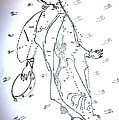20% off all products! Sale ends tonight at midnight EST.
Joined
2009
Followers
380
Visitors
1,458,540

Tarantella dance - Italy
Italian Folk Dance has been an integral part of Italian culture for centuries. Dance has been a continuous thread in Italian life from Dante through the Renaissance, the advent of the Tarantella, and the modern revivals of folk music and dance. The carol or carole (carola in Italian), a circle or chain dance which incorporates singing, was the dominant Medieval dance form in Europe from at least the 12th through the 14th centuries. This form of dance was found in Italy as well and although Dante has a few fleeting references to dance, it is Dante's contemporary Giovanni del Virgilio (floruit 1319-1327) who gives us the earliest mention of Italian folk dance. He describes a group of women leaving a church in Bologna at the festa of San Giovanni; they form a circle with the leader singing the first stanza at the end of which the dancers stop and, dropping hands, sing the refrain. The circle then reforms and the leader goes on to the next stanza.[1] The term tarantella groups a number of different southern Italian couple folk dances characterized by a fast upbeat tempo, usually in 6/8 time (sometimes 18/8 or 4/4), accompanied by tambourines.[2] It is among the most recognized of traditional Italian music. The specific dance name varies with every region, for instance tammuriata in Campania, pizzica in the Salento region. Tarantella is popular in Italy as well as in parts of Argentina. Tarantella dance has roots in Ancient Greece. It was a ritualistic dance in honor of the god of music and sun, Apollo, and god of wine, Dionysus. Ancient Greeks settled in Sicily, Naples, and Southern Italy, and continued this beautiful dance to this day. In the Italian Taranto, Apulia, the bite of a locally common type of wolf spider, named "tarantula" after the region[3], was popularly believed to be highly poisonous and to lead to a hysterical condition known as tarantism. The stated belief in the 16th and 17th centuries was that victims needed to engage in frenzied dancing to prevent death from tarantism using a very rhythmic and fast music. The particular type of dance and the music played became known as tarantella. The oldest documents mentioning the relationship between musical exorcism and the tarantula are dated around 1100[citation needed]. John Compton has proposed that ancient Bacchanalian rites that had been suppressed by the Roman Senate in 186 BC went underground, reappearing under the guise of emergency therapy for bite victims.[4] The tradition persists in the area, and is known as "Neo-Tarantism." Many young artists, groups and famous musicians are continuing to keep the tradition alive. The music is very differentâ€â€Âits tempo is faster, for one thingâ€â€Âbut it has similar hypnotic effects, especially when people are exposed to the rhythm for a long period of time. The music is used in the therapy of patients with certain forms of depression and hysteria, and its effects on the endocrine system recently became an object of research